 |
HMF had 2 trucks at display, both with the new 7020 model. This is a nice Volvo FH 8x2 of König & Kaiser.
|
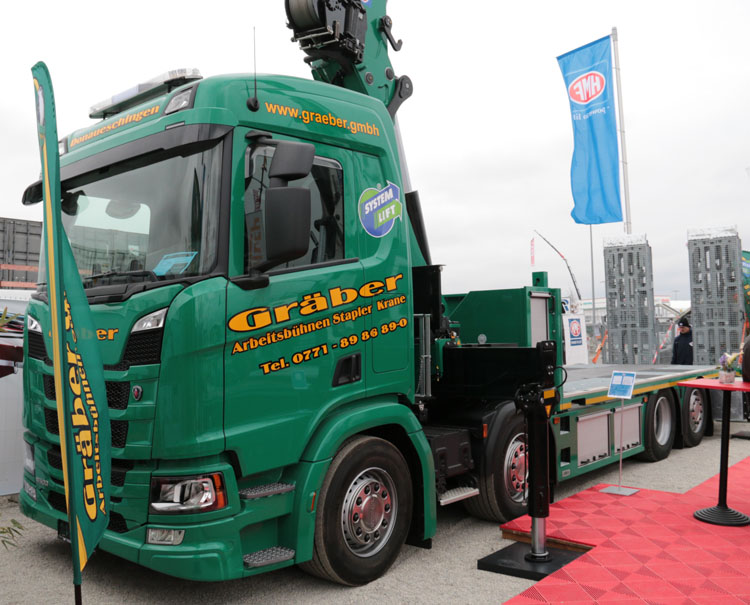 |
And this is a Scania R500 8x2 of Gräber. The HMF 7020 in K6 version can lift 2,96 tons at almost 17 meter. With the FJ1200 K6 jib that is 485 kg at nearly 30 meters.
|
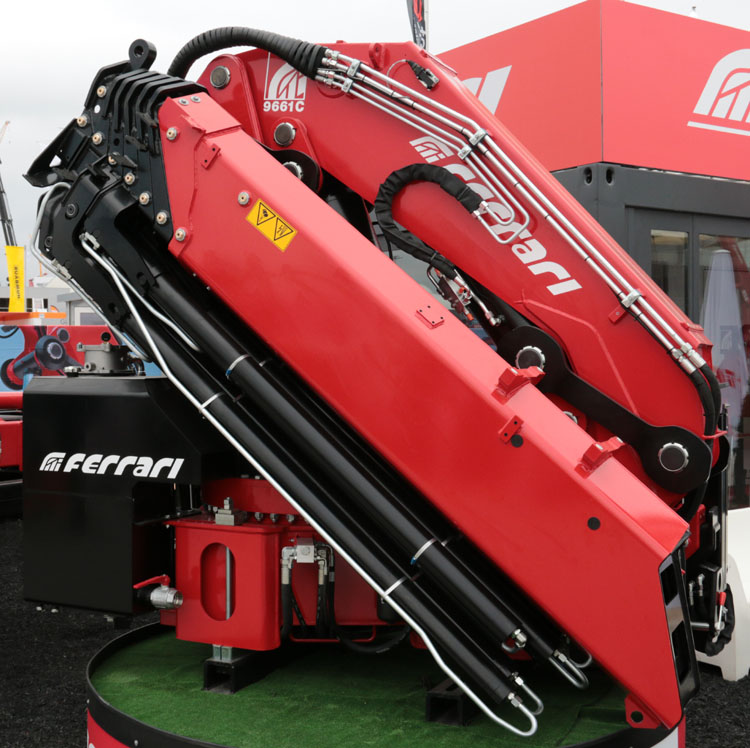 |
Ferrari, part of Hyva, displayed this new model. This 9661C crane in A6 version lifts 3135 kg at 16,13 meters. With a maximum of 4 manual parts, it can reach nearly 25 meters with 1,35 tons.
|
 |
MKG had this Mercedes Arocs 4143 8x4 of ES-GE Nutzfahrzeuge on display. On the chassis they installed a MKG HMK 991HP Ta2-a3. At the foot of the crane they installed sliding ballast and a cab.
|
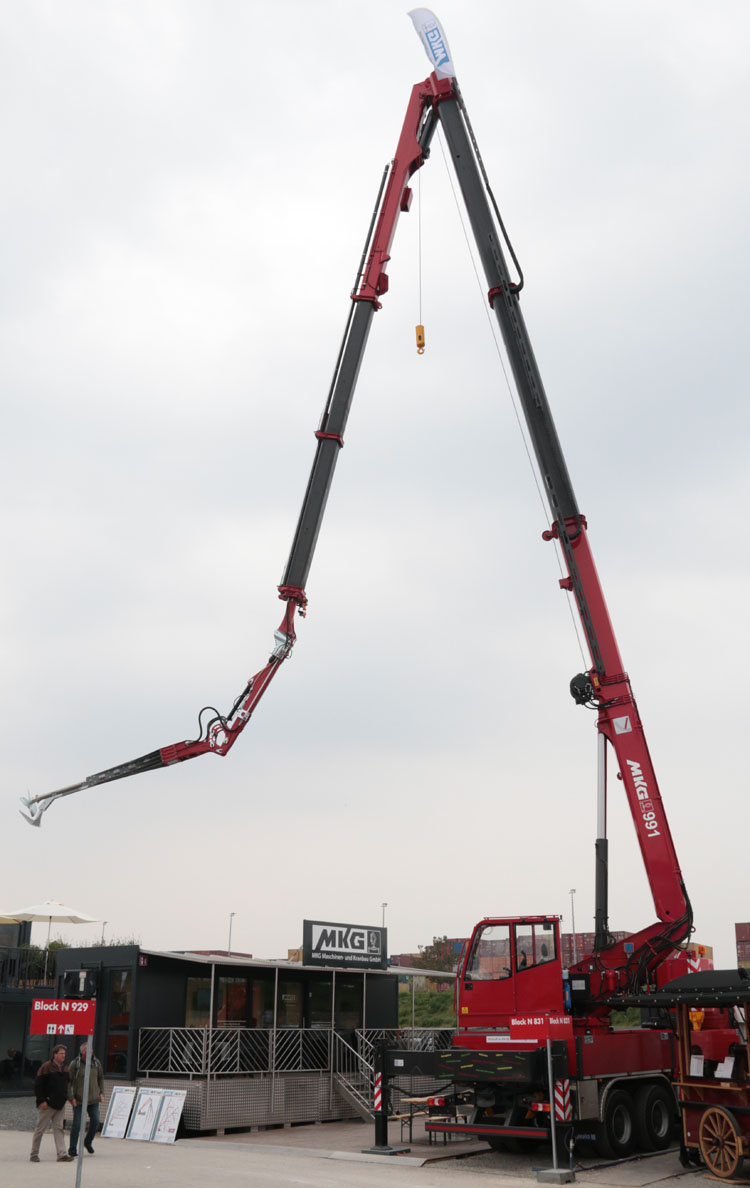 |
The main boom extends twice and the jib 3x hydraulically. Although the word jib may not be quiet correct here, it is rather a 2nd boom, as both parts are permanently connected to eachother. MKG cranes are not used for the outreach, but for the high lifting capacity at heights. With the 1st boom fully extended, the tipping height of the 2nd boom is at about 23,5 meters. At this height the 2nd boom can, at the inner hook, lift a load of up to 12 tons. With this boom fully extended, a load of 2,45 tons can be lifted at 23,5 meters height and 22,5 meters outreach. The maximum hookheight is 41 meters with 4 tons.
|
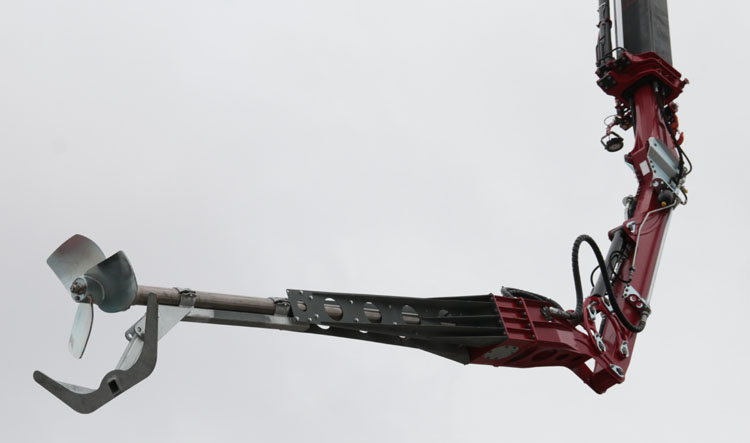 |
The stable construction of MKG crane combined with the height and outreach that it has, makes this a populair crane for construction and agricultural companies. The last category often uses such a crane with this attachment, a manure mixer. With this, the settler manure in a silo gets mixed up again so that it can be spread out.
|
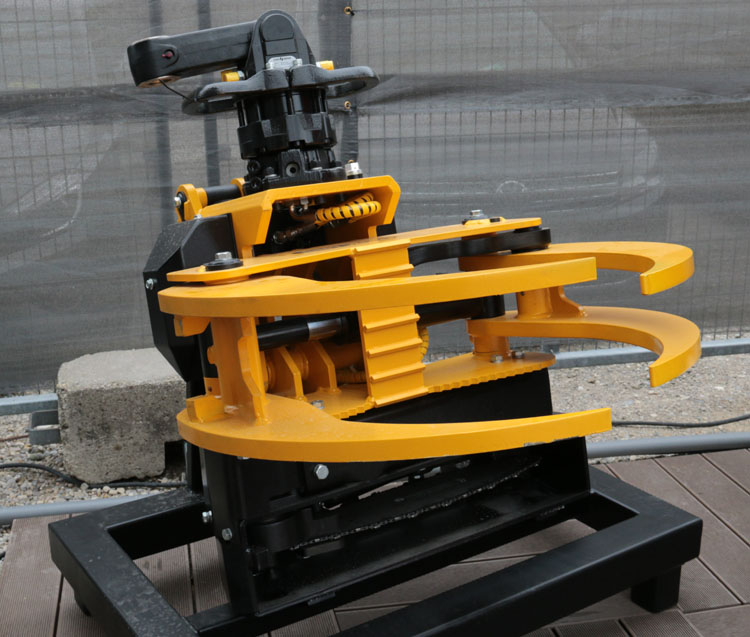 |
Another interesting attachment is this wood clamp with saw of GMT Equipment. The stable MKG cranes are also often used for the cutting of trees in difficult situations.
|
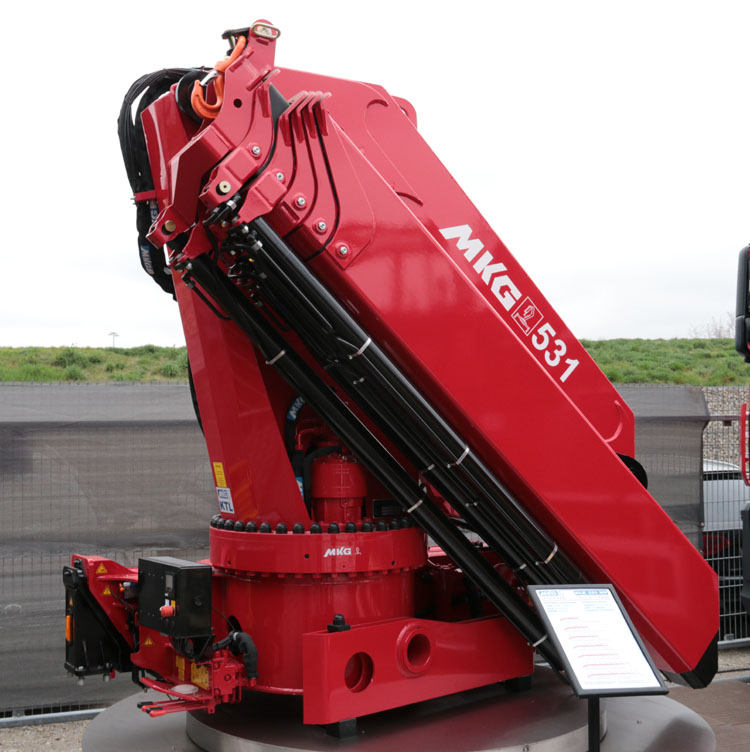 |
Foldable cranes are also available, this is the HLK 531 HP a5. It extends 5x to 14,1 meters with 3,03 tons capacity.
|
 |
Valla, part of Oil & Steel, showed this Valla V250E. It is an electrically driven crane with a maximum capacity of 25 ton. It has a hydraulic adjustable jib at the top of the boom. This machine can alse be used as a forklift, with a max. capacity of 10 tons at those forks. Machines like this are able to drive while lifting a load.
|
 |
A rotating rear axle is installed, which gives a high manoeuvrability. A big winch is installed at the back of the boom. The 4,74 ton of ballast that are mounted at the rear axle can be removed.
|
 |
More compact is this V70R, a crane that lift a maximum load of 7,7 tons. It lifts a maximum of 7 ton when it needs to move with this load. For more capacity the wheelbase can be increased (the rear slides out) or more ballast (2 x 900 kg) can be installed. Also the front outrigger beam, seen below the bumper, can be lowered to increase the lifting values, although moving is not possible anymore.
|
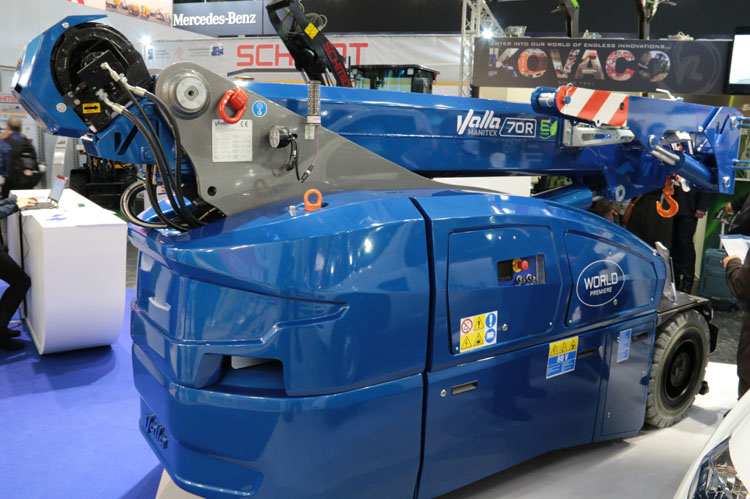 |
With these small cranes they now leave out the cab, as everything is operated with the remote.
|
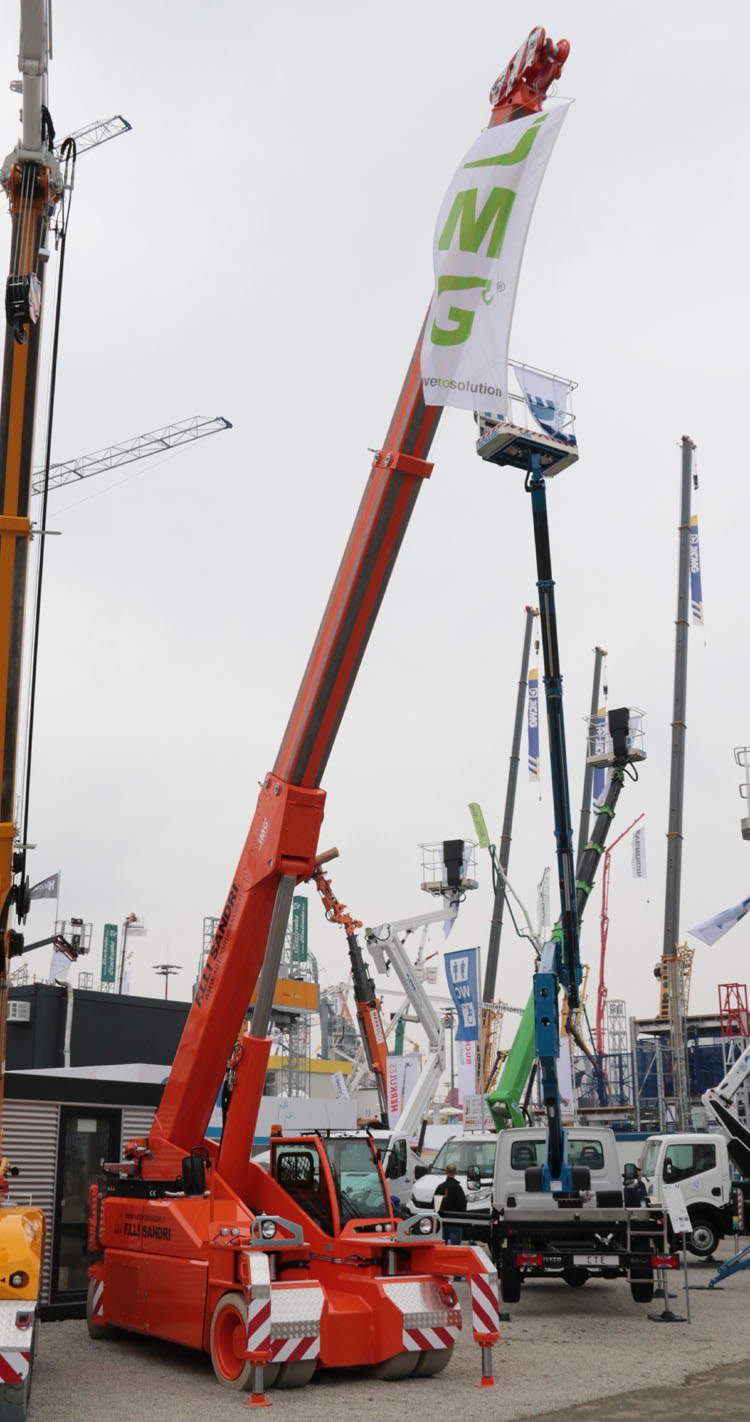 |
JMG showed several cranes, also this MC250 for F.lli Sandri. It can lift up to 25 tons and drive with that.
|
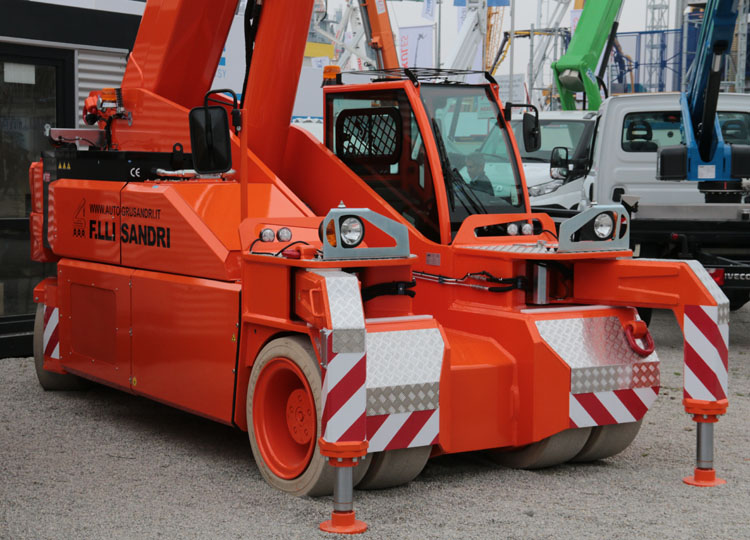 |
To get a bit higher lifting values, the front outriggers can be set down. The own weight is 28,1 tons, to that comes 7,3 tons of demountable ballast.
|
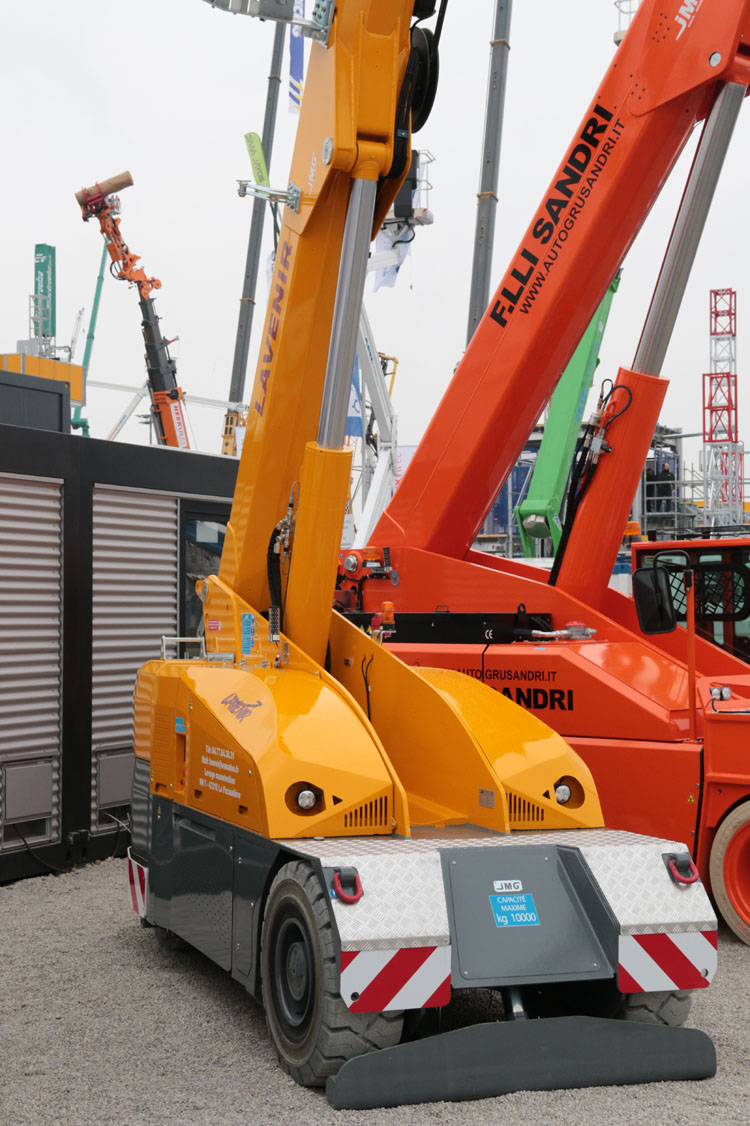 |
This is a 10 ton MC100S for the french company Lavenir. The support beam in the front gives a bit better lifting table then without, but the option to drive with the load is lost.
|
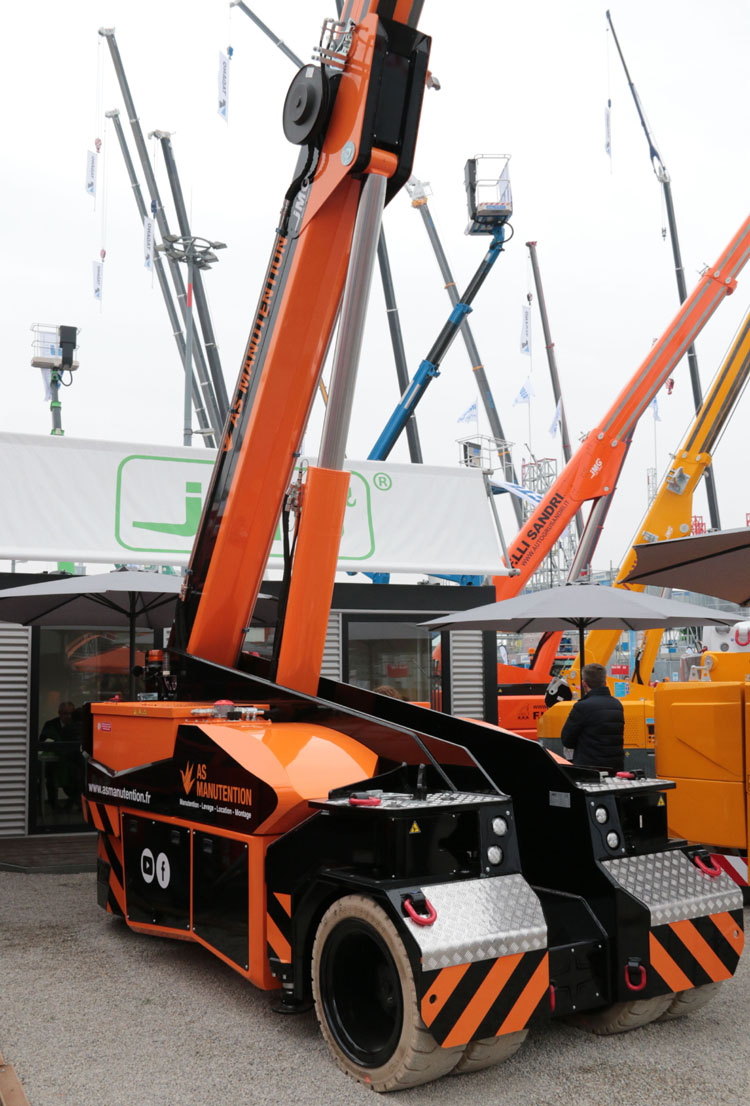 |
This is the MC180S, an 18 tons electical pick & carry crane. It is for the french AS-Manutention. This unit also 2 small outriggers for more capacity at standstill.
|
 |
The company Mehrbreier-TransMeWo owns this heavy MC450S, a 45 ton pick & carry crane. The own weight of this machine is 35,8 tons, to this comes 10,6 tons of ballast.
|
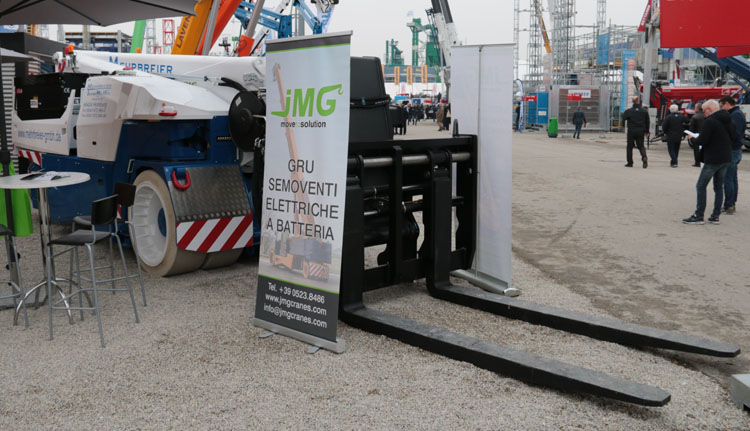 |
The rear axle can be moved to the rear for 1 meter, giving additional lifting capacity. Also the outriggers at the front can be set up to create more capacity. Forks are possible, as can be seen here.
|
 |
This machine of Herpertz didn't had a modelname, I guess that it is a 13 ton version.
|
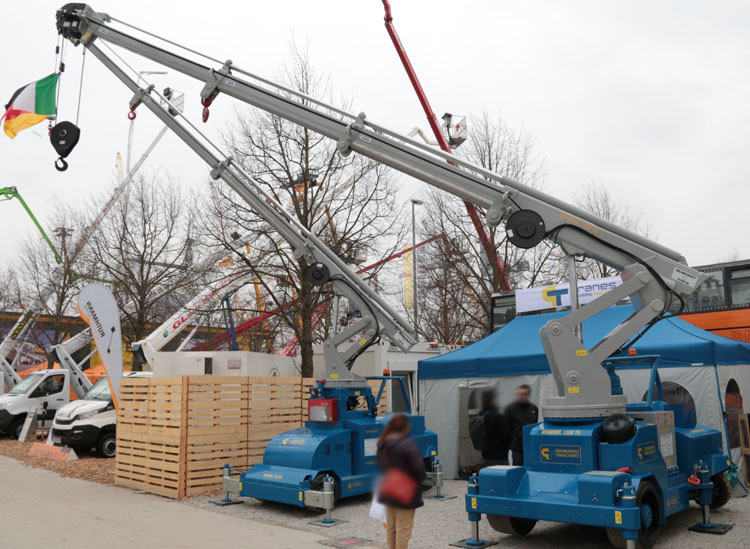 |
The company Gruniverpal Tranchero builds these special indoor cranes. To the left we see the Minidrel 75B TRS and to the right the 125B TB. The left can lift up to 7,5 tons, the right will pick a load of up to 12,5 tons.
|
 |
Ormig had several units on display. The left crane is a 33 tons version for Transpico in Belgium.
|
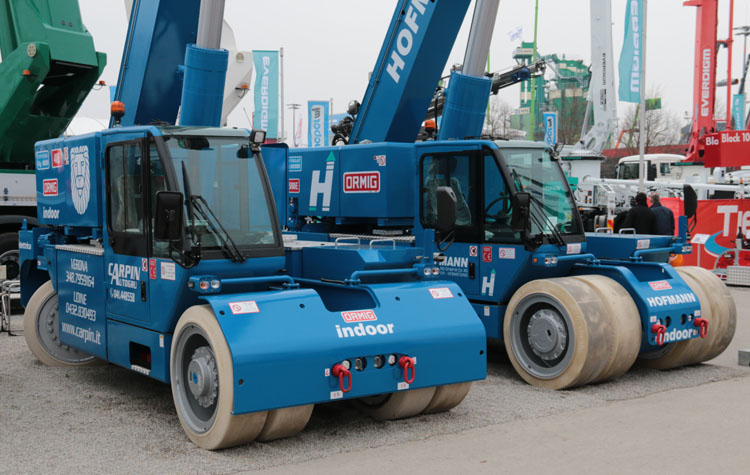 |
This unit goes to Carpin Autogru in Italy, it is an 40iE, meaning it has up to 40 ton capacity.
|
 |
Even heavier is this 55/60iE of Hofmann from Paderborn. This unit can lift 60 ton at 1 meter of the front of the crane and drive with that at about 1 km/h.
|
 |
The company Marcus from Wuppertal also ordered a 55/60iE for their fleet.
|
 |
Idogru had a Scania G500 8x4 on their stand that was equiped with a KT160.36 crane, owned by Bettarini. This is a 160 ton crane with a boom height of 36 meters.
|
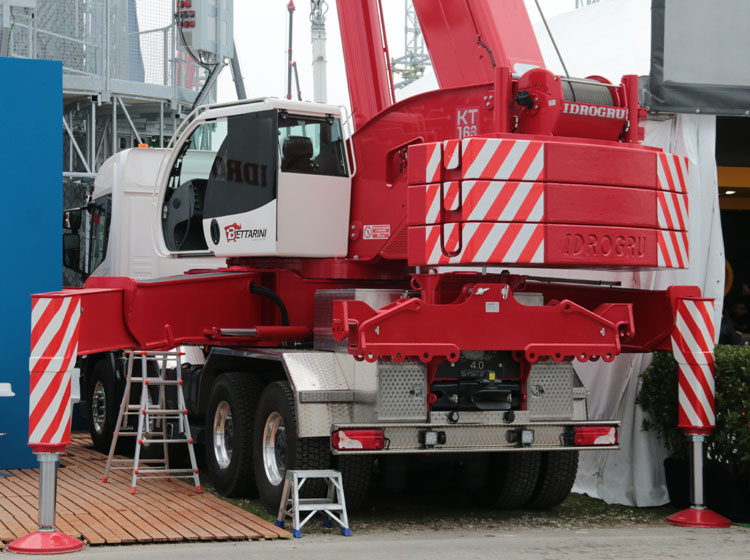 |
The crane has got 3 x 4t of ballast installed. During road transport 1 of those stays on the crane, the other 2 are put at the back of the chassis. During transport the crane lies down in reverse direction.
|
 |
Marchetti displayed this MTK60 crane on a Volvo FMX 8x4. This crane has got 60 ton capacity with a 40 meter boom, that can optionally be equiped with a 14,5 meter jib.
|
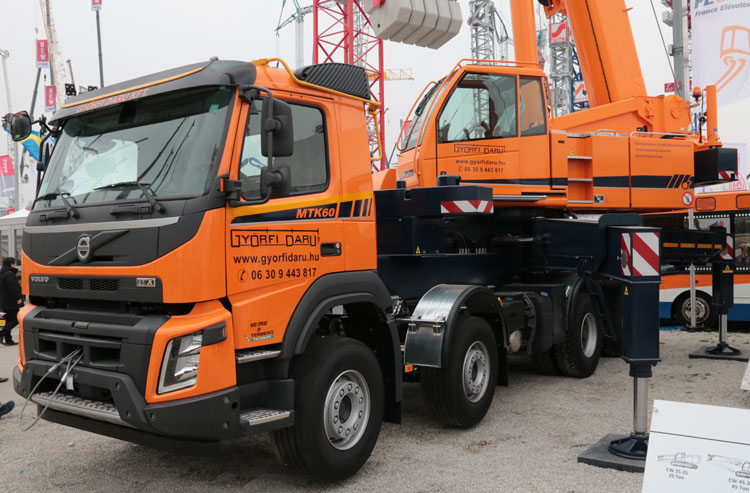 |
The total weight of the crane is indicated with 35 tons. On top of that comes 6 tons of ballast. This crane is owned by Gyorfi Daru from Hungary.
|
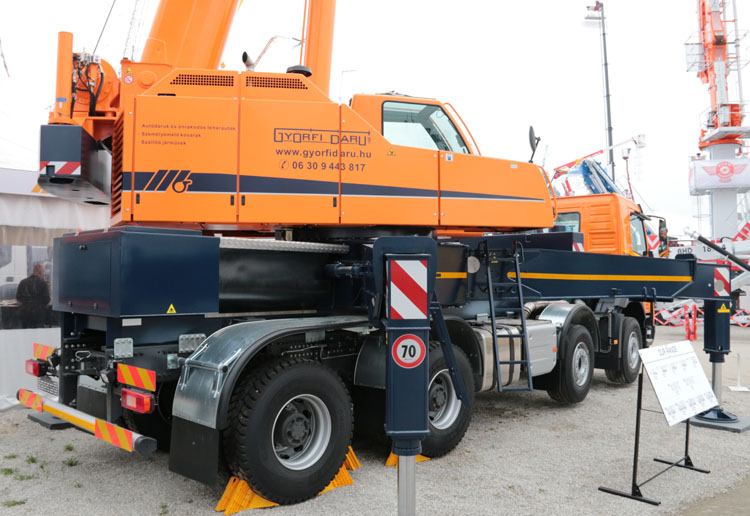 |
Particularly interesting for me is the chassis, this is Terberg conversion of a standard FMX. The rear axles where put at a 1,8 meter distance and equiped with hydropneumatic suspension. The last axle is steered with hydraulic cylinders. Probably the axle load can now be higher in Hungary. Also this solution offers better manoeuvrability.
|
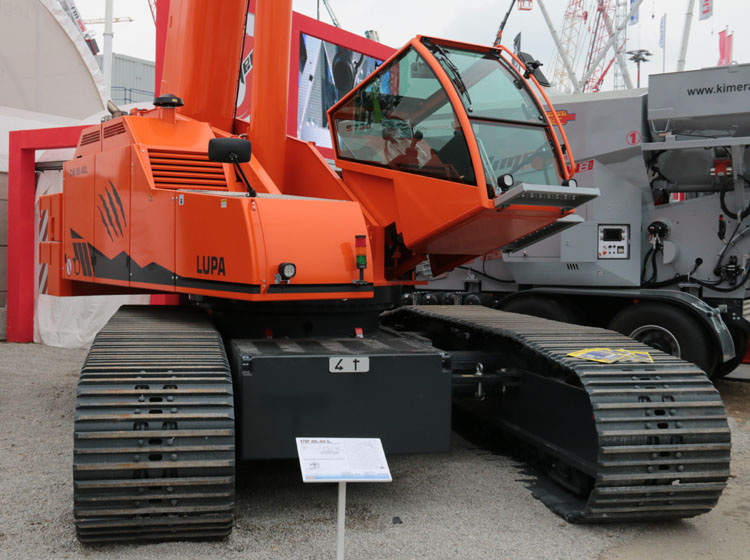 |
This is the CW 65.40L crawler crane. It can lift up to 65 tons, has a 40 meter boom and 14,5 meter extension. It weighs in at 52,8 tons. The crawler's width is adjustable for easier transport.
|
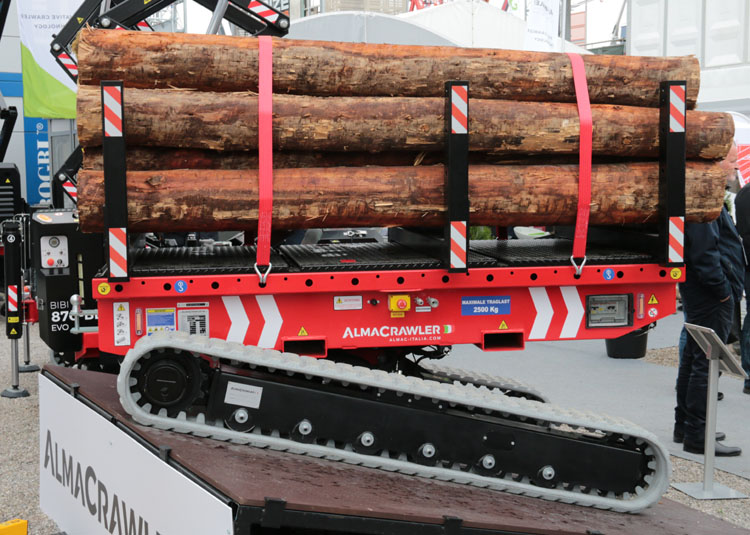 |
This is the AlmaCrawler, a handy small tracker carrier that can even keep the load level at slopes. The maximum capacity of this unit is 2,5 tons.
|
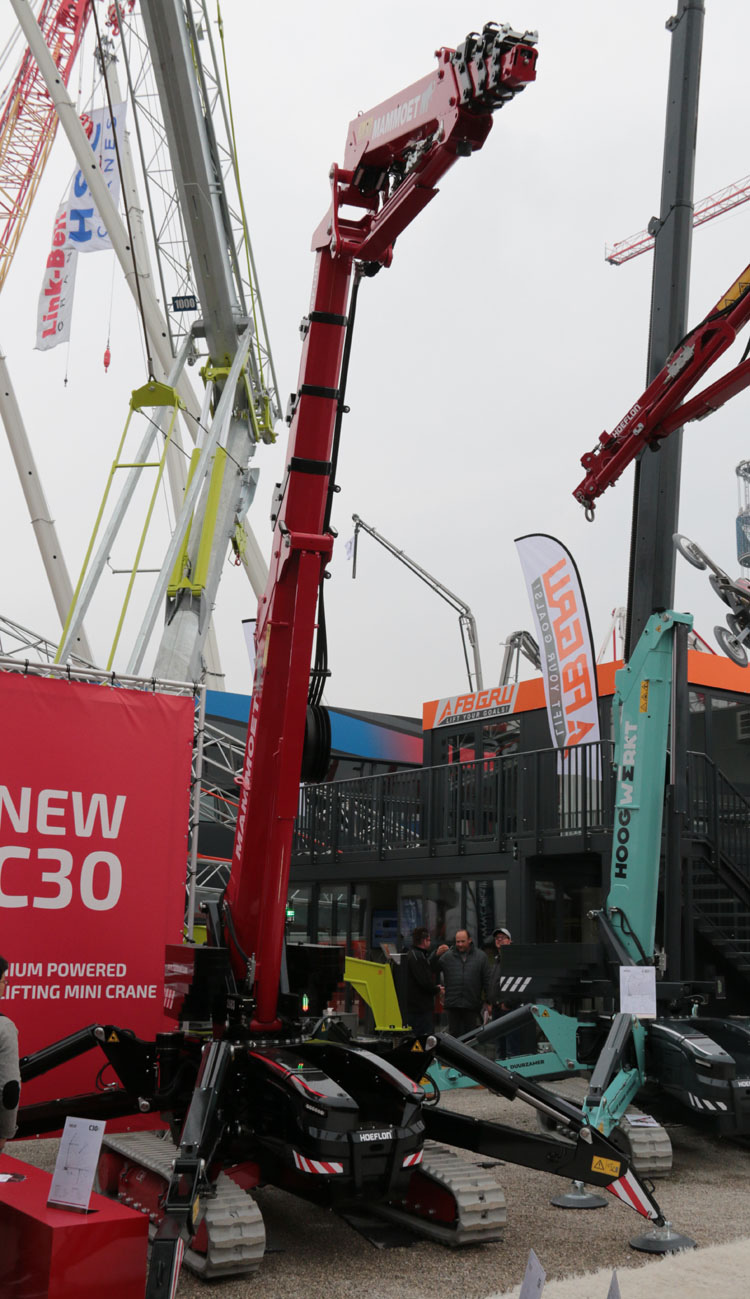 |
Hoeflon showed their new C30e, this one is for Mammoet. With 9 ton own weight, it has a capacity of maximum 8 tons. Interesting is that the main boom can be set up at an angle of 95°, which means it doesn't only stand straight up, it even exceeds that with 5°. This way the crane can stand even closer to a building and still be able to go through an opening with the jib.
|
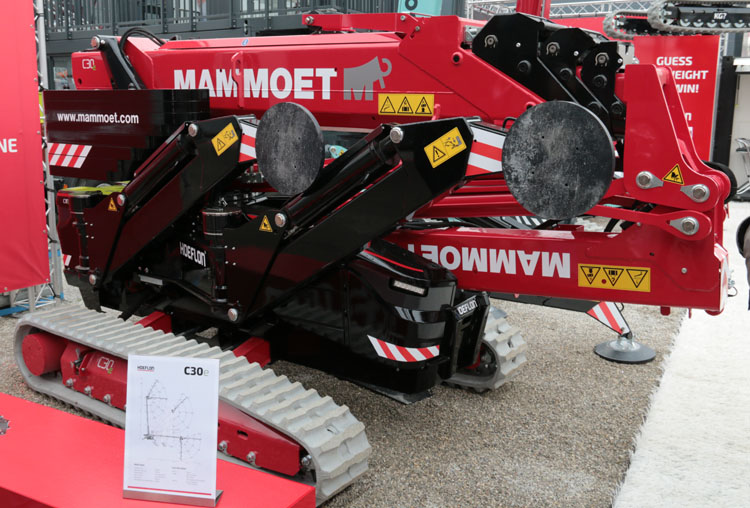 |
With the outriggers tilted in, it becomes rather compact. The tilting height of the jib is at about 15 meters, the maximum outreach is 20 meters with 420 kg.
|
 |
Here we see a 2nd C30e, now with the outriggers down. The outriggers are flexible in their setup, depending on the amount of available space.
|
 |
To accompany the Hoeflon mini cranes, they now also offer this TC1. This tracked carrier with a capacity of 1200 kg can bring the load to the mini cranes.
|
| |
|